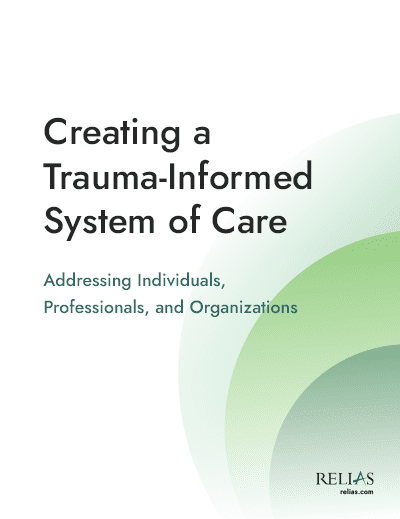Trauma-informed care (TIC) is a crucial piece of the behavioral health landscape. It’s a framework that puts the person at the center of care and allows their needs to drive the approach to care. In true TIC, the practitioner will ask “What happened to you?” rather than “What’s wrong with you.”
Many behavioral health organizations have started to use TIC practices when interacting with clients, as well as staff. But becoming truly trauma-informed is often easier said than done.
To help your organization become trauma-informed, we’ve put together this resource that answers common questions around implementing and using TIC practices. We hope this post, as well as the other resources we have available on trauma-informed care, will help to inform your journey to becoming a true trauma-informed organization.
Table of contents:
What is trauma?
Before you can begin offering trauma-informed care to clients and transforming into a trauma-informed organization for your staff, you must be able to identify what trauma is.
Trauma results from a single incident, group of incidents, or situations that overwhelm an individual’s ability to cope. The experiences are disturbing or life-threatening enough to cause ongoing, significant impairment in multiple areas of functioning. Trauma can affect communities, families, groups, and generations.
What causes trauma?
It’s important to note that trauma, both its causes and effects, does not look the same for everyone. Indeed, not everyone who experiences trauma will develop behavioral health conditions. Trauma-related disorders typically form when there is a delay in seeking treatment or an individual has practiced forms of avoidance. This is why TIC is so crucial.
While trauma takes many forms, some common examples of trauma include:
- Experiencing or witnessing emotional, sexual, or physical abuse
- Facing chronic poverty and/or homelessness
- Being physically or emotionally neglected during childhood
- Being raised by someone with an untreated behavioral health disorder
- Experiencing or seeing violent acts in the home, community, or in other areas (for example, military combat)
- Losing a loved one suddenly, unexpectedly, or violently
- Surviving a natural or human-made disaster
What are the impacts of trauma?
The impacts of these events can go well beyond the days or months following them. Trauma, in fact, is a major public health issue and its effects go far past the initial physical or psychological impact. It can alter a person’s behavior and biology throughout their lives, their relationships, and even later generations. Trauma can even extend beyond the individual and affect entire communities and societies.
With this knowledge of trauma in hand, let’s explore some ways in which you can use a trauma-informed care approach to care for both your clients and staff.
What is client-facing trauma-informed care?
Trauma-informed care has become a widely recognized paradigm for creating safe spaces for individuals who have experienced trauma and reducing the likelihood that accessing services would cause re-traumatization. The impact of TIC on individuals and organizations is powerful, and this approach has proven effective in reducing trauma-related symptoms.
TIC is different from other models of care, as it can be used in any type of service setting or organization. By using this approach, you can gain awareness of ways to anticipate and avoid institutional practices that are likely to re-traumatize persons served. It also focuses on the individual’s strengths and encourages their participation in the development, delivery, and evaluation of TIC services.
Why must an organization screen for trauma?
Trauma screening is a vital part of providing trauma-informed care. Screening for trauma allows for accurate treatment planning and service provision. Therefore, all clients should be screened for trauma, regardless of what services are sought.
Screening can be accomplished by any trained staff member. The screening process is often the first interaction a client has with any staff, and it sets the stage for treatment.
Trauma screening should be done as early in the intake process as possible. However, screening is merely the beginning. Organizations should have a specific process to guide staff members through the screening process as well as training them to screen for trauma during an intake. The information gathered during the screening process will help determine the appropriate next steps and the treatment plan.
How does TIC relate to adverse childhood experiences (ACE)?
Unresolved trauma can lead to a host of symptoms and adverse effects. When a child suffers trauma or seriously adverse experiences, it can cause psychological damage that, if left untreated, will worsen over time.
“Researchers have been exploring the question of the impact related to the frequency and numbers of a single category of ACEs,” said Kristi McClure, LCSW. “There are even some studies and research that indicate experiences in utero can impact the child post-delivery.”
These studies have shown that using a trauma-informed approach to ACEs is crucial. This is because trauma-informed care and approaches can prevent and treat early symptoms of ACES, which could markedly decrease the prevalence of substance use, suicide, and risky behaviors that could be detrimental for public health.
It has been found, in fact, that positive childhood experiences can greatly reduce the long-term negative impact of ACEs on an individual. Further, adult-reported social and emotional supports can also reduce the detrimental effects and symptoms that stem from adverse childhood experiences.
By creating systems and support to reduce ACEs, increasing positive childhood experiences, and providing structures that are emotionally and socially supportive to adults, the negative impact of ACEs can be mitigated a great deal.
How can TIC help with racial trauma?
Racial trauma is any number of adverse effects that racism has on the well-being of individuals, communities, and cultures. These events are stressful and traumatic to those who go through them. While racial trauma is like PTSD, it is different because of perpetual exposure to race-based stress by individuals and communities.
People of color who experienced trauma related to racism are often invalidated by those who do not have the same lived experiences or do not understand how a particular event or situation could be traumatic. Such invalidation is harmful to the traumatized individual. This is why trauma-informed care is so important to helping clients heal from the effects of racial trauma.
When working with people of color, consider racism in both historical and current contexts. “Examples of historical trauma include African American Slavery, the Holocaust, the internment of Japanese populations during World War II, and land seizures and genocide committed against Native Americans,” McClure added.
Therapeutic interventions may be most effective when racial trauma is addressed and treated as the trauma that it is. This type of therapy promotes an understanding of a client’s experiences as a requirement for the delivery of proper care. To begin offering trauma-informed care to clients coping with the effects of racial trauma, use the following strategies:
- Address self-blame and rumination.
- Encourage physical exercise.
- Recommend participation in positive, community-based activities.
- Make medical/psychiatric referrals as needed.
How can organizations become trauma-informed?
An organization working within a trauma-informed framework involves all aspects of the business and all employees and works on transforming the whole organization. It’s more than about specific interventions with clients and isn’t simply about face-to-face interactions. It’s in attitudes, beliefs, documentation, physical environment, and how everyone treats each other.
First, a trauma-informed organization’s mission is grounded in trauma-informed care principles and practices. Trauma-informed care is the organization’s way of doing business, and thus everyone in the organization needs to understand and embrace it.
“Essentially, it boils down to understanding that staff have their own trauma histories and are impacted by the work,” McClure said.
How can organizations use training to become trauma-informed?
Training is one of the most important factors to creating a trauma-informed organization and workforce. As mentioned previously, all staff at an organization should be given training on the basics of trauma and the elements of trauma-informed care.
Furthermore, clinicians and those staff who practice any direct services should receive more in-depth training in screening, assessments, and how trauma is related to substance use and mental health disorders. Taking the time to provide staff with adequate training during initial onboarding and throughout the first 30 to 90 days of employment is also beneficial.
Direct care staff should not be thrown into work with persons served prior to receiving adequate training on trauma-informed care, crisis prevention and de-escalation, and how to recognize and report abuse, neglect, and exploitation. Staffing challenges may tempt providers to expedite onboarding, but a staff member who is not fully trained on trauma-informed topics is at a higher risk of re-traumatizing persons served.
Ongoing training and continuous education can have a huge impact on the well-being of direct care staff and clinicians. When work demands and pressures are not matched to the employee’s knowledge, skills, or abilities, they will struggle significantly more than an individual who already has the necessary skills or experience to work with trauma survivors.
Do organizations need to provide TIC training to non-clinical staff?
Yes! For an organization to truly become trauma informed, it must involve everyone — this includes nonclinical staff such as receptionists, peer supports, and paraprofessionals.
Every contact an individual has with someone at your organization will either contribute to (or detract from) a safe and trusting environment. For this reason, it is crucial that all staff members, regardless of their roles, be given the same trauma-informed training and communication as clinical staff.
“Trauma-informed care is the organization’s way of doing business,” McClure noted. “And thus, everyone in the organization needs to understand and embrace it.”
How can organizations create TIC-informed policies and procedures?
Attention to language is important when considering policies and procedures, as well as honoring the basic paradigm shift and principles of trauma-informed care. Behavior management policies, such as level systems, are one example of an area that is often reworked when an agency strives to become trauma-informed.
These policies often focus on consequences and rewards that are not effective with people who have experienced trauma.
“Codes of conduct for people served by the organization is another example of a policy that is often changed as the result of a trauma-informed initiative,” McClure noted.
In addition, staff policies should be rewritten to reflect an increased understanding of the impact of trauma on the workforce.

Creating a Trauma-Informed System of Care
While we’ve covered a lot of ground here, there’s still a lot more to learn about trauma-informed care. Download this e-book to learn best practices for addressing trauma with the individuals you serve, how to become a trauma-informed organization, including the key elements of the trauma-informed model of care, and more.
Learn more →





